I often get asked “what do you use to produce your podcasts?” So, while this might not be of interest to all, I thought I'd put it in a blog post that I could refer people to as a starting point. I hope that sharing this will help people realize that podcasting isn't that hard and it doesn't require any expensive gear.
I hope we'll see even more Lean podcasting, just as we've seen an explosion of Lean blogging. When I started, I relied on the book Podcasting For Dummies. It was published in 2008 and hasn't been updated, I believe. You can probably find good online resources, or even podcasts about podcasting, I bet.
Updated February 2022
Recording
What hardware and software do I use for recording?
Computers
I started doing my podcasts in 2006 using a Windows laptop, but have since (2008) converted to Mac. In my home office, I use a 14″ M1 MacBook Pro (the 2021 edition) with a docking station, monitor, etc.
Microphones
You will probably want to upgrade from your laptop's built in microphone. I started with a fairly basic headset mic and earphone combo, sort of like this (about $15). You can get these with a USB connector or separate mic/headphone inputs. My MacBook doesn't have a separate mic input, so USB headsets or mics seems to be the way to go for many users. I probably used that headset for about my first 30 or 50 podcasts.
I bought a separate dedicated USB mic that I used probably through about Podcast #120 or so, it was a Blue Microphones Snowflake USB Microphone. I think the sound quality was better and this was a portable unit that easily fit into my travel computer bag. It was probably due to all the travel, but the mic's casing cracked and the microphone literally came apart on me after two or three years. But still, it was about $90 then and it's only about $50 now. I'd still recommend the mic, if you take care of it, as Blue is a well-regarded brand (their Blue Microphones Snowball USB Microphone is less portable, but supposedly a little better).
Today, I'm using, connected to my computer, a Audio-Technica AT2020 USB Condenser USB Microphone. It's about $100 on Amazon. I have it set up with a heavier desktop stand ($12), a shock mount ($30), and a pop filter ($15).
I later switched to a boom arm that mounts to the side of my desk ($25)
Since I'm playing around with an audiobook version of my book Lean Hospitals, I built a homemade “sound booth” to enclose the mic (basically like this) to reduce echoes from my office's walls. It's easier to put a box around the mic (and take it down) than to put soundproofing up all over the room. This is probably overkill for podcasts, but it was only about $35 of materials to make it myself. I call this my “Minimum Viable Booth” as the foam isn't yet trimmed or glued into place. 2020 Update: I generally don't use this now.
Update 2021: Upon recommendation of a colleague at KaiNexus, I added this Kaotica Eyeball “portable sound booth” ball to my microphone… which works much better using the boom stand that I now use. I should add a photo of that.
To eliminate any possible echo when recording, I plug in and use a pair of in-ear earbuds (into the jack on my external speakers). More recently, I've started using my AirPods, which I love, to connect to either Mac. Pro tip: Don't use the AirPods as a microphone.
Update 2021: Zoom is pretty good about preventing echo, so I usually don't worry about the earbuds now.
Webcam
I've used this external webcam for four or five years, especially since I've been recording video to share episodes on YouTube.
Software
I am using Zoom.us, which has built-in recording for calls, as it records each person's audio in separate tracks, which helps with sound leveling and editing. Zoom also records video for when I also post the video on YouTube (like this one).
I have also experimented with browser-based services like Riverside.fm and Zencastr for recording — there are many pros and cons to using services like those. Recording quality is generally better, but it's easier for people to join Zoom at this point.
I was asked to answer a question about podcast software as part of the tips collected here.
Producing
I don't spend too much time on post-recording production. Most of the time, my guests and I record straight through as a single take, with any verbal stumbles being left in. I sometimes cut out any long pauses that are there before or after a question. I could probably get better at adjusting and tweaking sound levels in my podcasts, but the benefit to time ratio doesn't seem good. Update: In 2015, I started taking better advantage of “leveling” and “normalizing” tools in Audacity.
For sound editing (or for recording directly into the Mac), I use another piece of free software called Audacity. I started using this back when I had a Windows PC and it was an easy transition to the Mac version. I have tried Garage Band and others swear by it, but I have found Audacity easier to use.
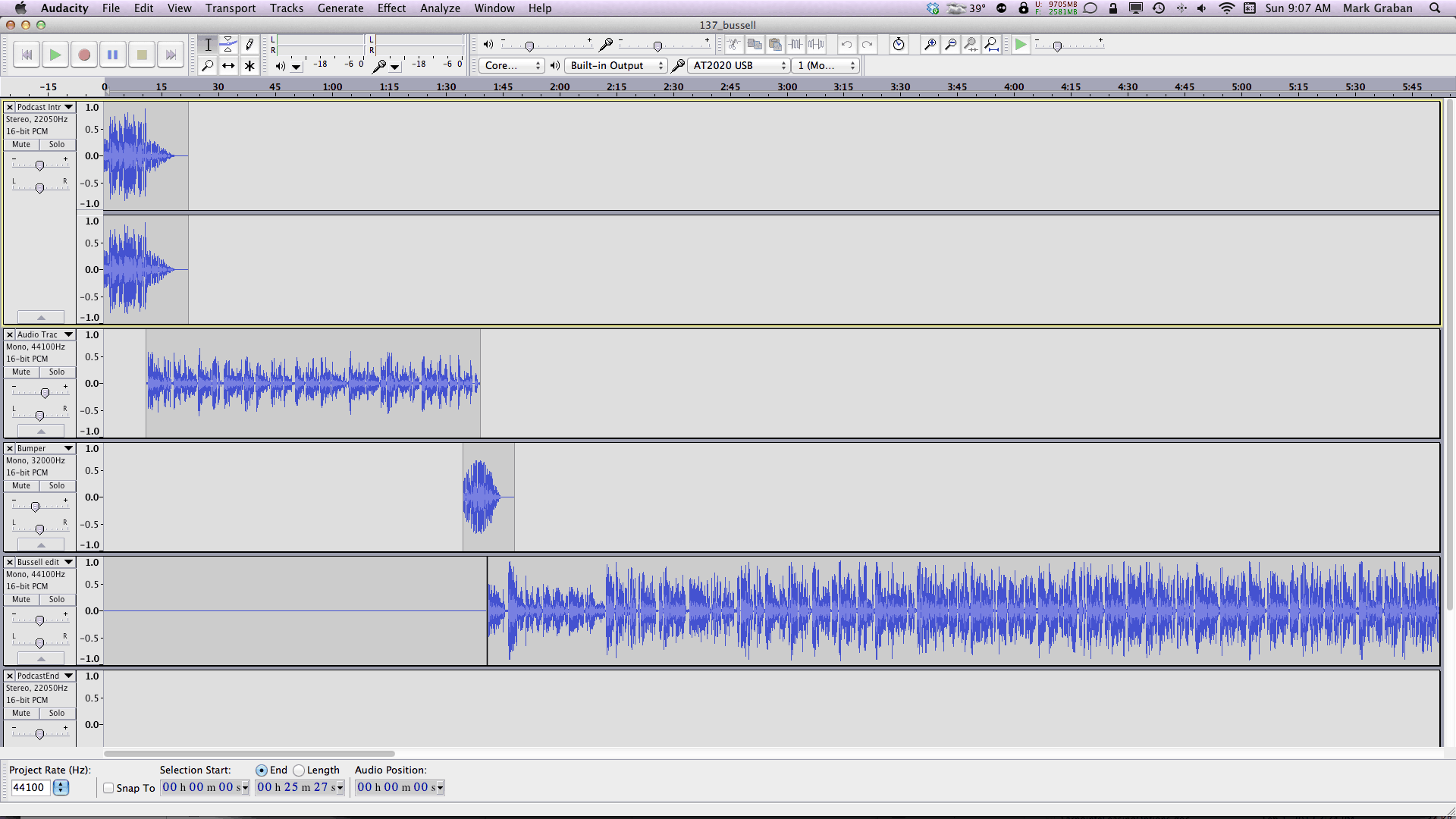
With Audacity, I can combine the podcast interview tracks with my intro music, my introduction track, “bumper music,” and my outro music.
2019 Update: I've started using software called Hindenberg Journalist, and I think it works better for these purposes. It was $95 but seems worth it. I sometimes use Audacity for noise reduction, if needed, and then do final editing in Hindenburg.
2021 Update: I now use Hindenberg Journalist Pro, which has noise reduction and other features.
I was asked to answer a question about podcast software as part of the tips collected here.
I use iMovie to edit and process my video. I create “overlays” using Canva.
I use Hindenburg to publish the finalized podcast as an MP3 file.
Announcer
The announcer who introduces me is my friend Steve Sholtes, a multi-talented fellow who has done some voice work for his local NPR station back home in Detroit. So this was free (annoyingly, Steve wouldn't let me pay him). If you want an announcer, get a friend with a good voice or you can pay to have somebody so this online. The intro music, which I also use for the “bumper” transition between my intro and the interview is a piece of “royalty-free” music I found online. You can either pay for a royalty-free track or you can find free tracks that are also royalty-free.
Uploading and Hosting
Since 2009, I've been blogging on the WordPress platform, which has some built-in podcasting tools I probably could be taking advantage of. But, when I was blogging on the Blogger platform, I had to find a separate podcasting host service and it works, so I've stuck with it.
Originally, I paid $9.95 a month to use a service called Hipcast to host my files. I log into Hipcast and upload the MP3 file along with some descriptive text. Hipcast then allows me to:
- Publish the podcast into an RSS feed (which I run through the Feedburner service)
- Push the podcast to the iTunes Store (I had to set up a podcaster account through iTunes, which is free)
- Embed a streaming audio player into my blog (I create a blog post / web page for each podcast)
I also share MP3 file as a link from Hipcast's hosting. Hipcast has basically given me, for my purposes, unlimited disk space and bandwidth, even as I'm over 300 podcasts.
2020 Update: Last year, Hipcast had a tech meltdown for a while, so I moved over to a more premium host called Podbean.com. I can share an embed and direct MP3 link as I did with Hipcast. Podbean allows me to insert my own “house ads” that I can use to promote my books, etc. I can also earn a bit of income from other ads, if I want. Podcast costs more than Hipcast, but it's a bigger company and I trust their product more. I blogged about this.
I also use anchor.fm as a free (and capable) host for some of my other podcasts, like My Favorite Mistake. I generally recommend that service now to post podcasters.
Also, I have a checklist that I have used and modified over time — although I don't really use the checklist anymore.
Counting Listeners
One question I often get is “how many people listen to each episode?” Counting visitors to a web page is very easy and straightforward (although just because somebody loads a blog page, it doesn't mean they read it).
Podbean and Apple give me download counts, but I'm not sure how reliable the counts are. Downloads don't equal the number of listeners. Let's say somebody shares the MP3 on an internal computer network or other sites…
It seems each new episode currently has about 1,000 downloads that happen in the first few days.
I have to give Norman Bodek credit because it was his suggestion, in early 2006, to “do a lean radio show” that turned into this podcast. He was my very first guest and he remains a very dear friend.
A photo of my overall setup in 2012:
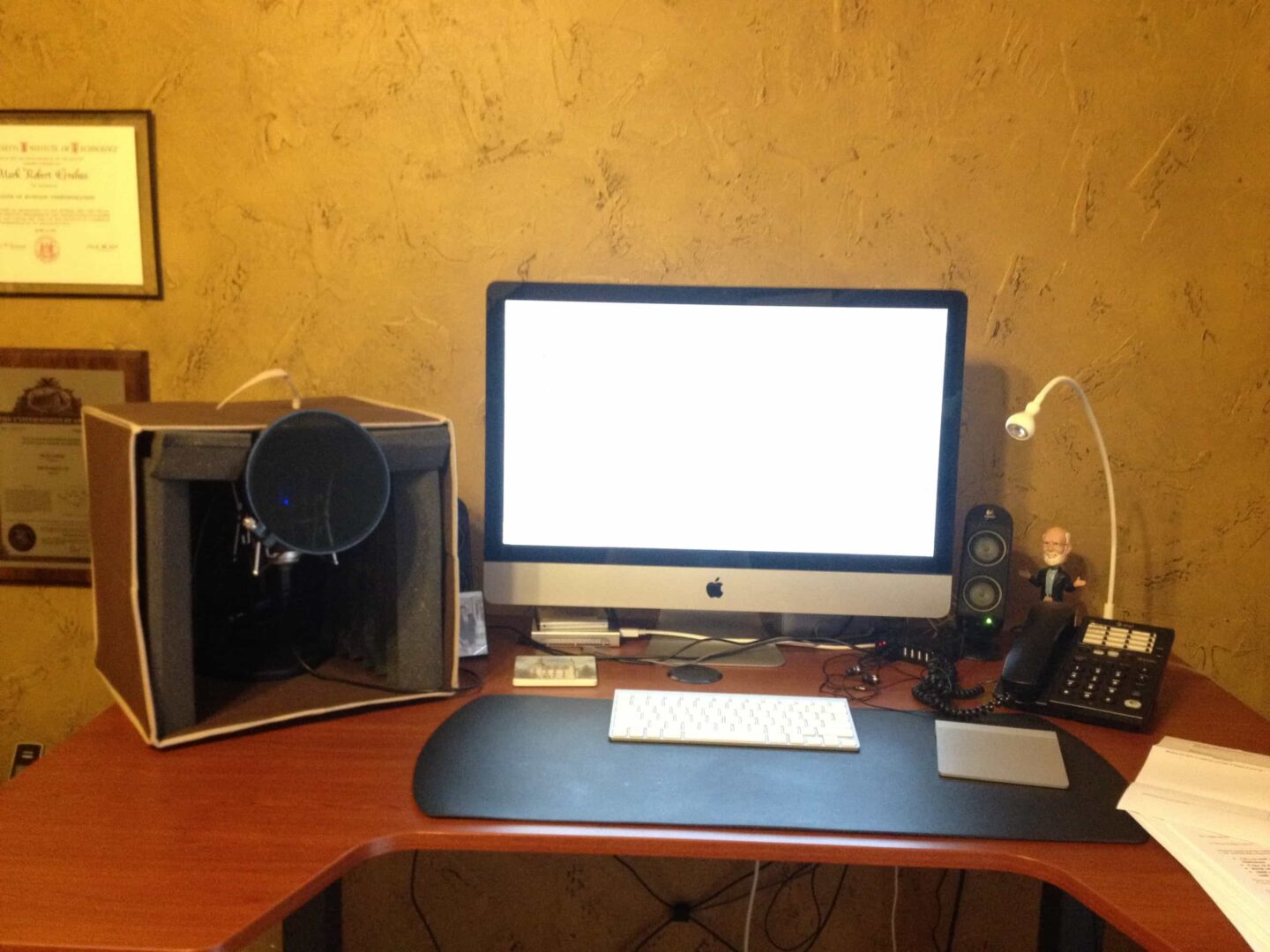
I should clean up my desk enough to take a photo of my 2018 setup, but it's not much different other than being in a different home (and I don't use the foam box, really).
Please scroll down (or click) to post a comment. Connect with me on LinkedIn.
Let’s work together to build a culture of continuous improvement and psychological safety. If you're a leader looking to create lasting change—not just projects—I help organizations:
- Engage people at all levels in sustainable improvement
- Shift from fear of mistakes to learning from them
- Apply Lean thinking in practical, people-centered ways
Interested in coaching or a keynote talk? Let’s start a conversation.




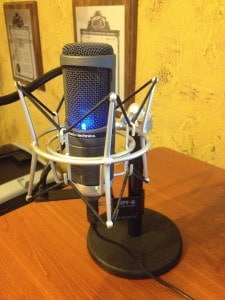
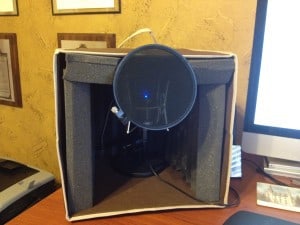

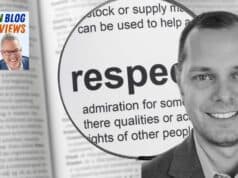




Thanks for the info.
I am going to forward this to my sister since she is wanting to start her own podcast about coupon’s.
Good idea on the homemade sound booth will cut down on any of the back ground noise. I look forward to the audio book for my commuting college.
Thanks for asking the question, Dwain. I’ve given similar (shorter) answers to people via email many times, so it was about time that I posted a standardized and more complete response on the web.
This way, I might also get ideas and suggestions from listeners who are also podcasters.
I think this demonstrates that podcasting doesn’t have to be a huge investment. I had always wondered about simple software solutions for recording calls and inserting sounds as well as acoustic setups. I haven’t done any phone interviews in seven years, and I used a land line with a splice to a mini-tape recorder – stuff good for collecting data from interviewees but not creating recordings for public consumption. Thanks for sharing.
That reminds me, Chad, to add a few notes about using Skype to call out to regular phones…
Dear Mr. Graban: just a picayune question. Where did you obtain the ‘cone’ over the mic, or how did you make if it is self made?
Dr. Miller – see in the post for the description of the “sound booth” that I made.
Dr. Miller:
That’s not a cone. It’s a flat circle called a pop filter, and it mutes the pops and clicks in one’s voice, that don’t translate well to digital audio. Most podcasters have one. They’re like $20.
Hope this helps,
John Dunagan